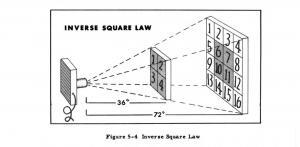

Another variation on this is X watt will go Y distance. Neither of these is true because the situation is not linear. Rather than the energy being conducted along a straight line, it is being dispersed into a three-dimensional environment. In free space, the signal will actually follow the inverse square law, because of the expanding area as you get further from the antenna. Doubling the power from 4 watts to 8 watts will only result in a 1.4 times increase in distance in free space. It would take increasing the power from 4 watts to 16 watts to double the range. In addition to dispersing the energy over an area, there are additional losses due to resistance and obstructions that will shorten the range further. This is why the “35 mile” walkie talkie bought at the department store never performs up to what was claimed on the package.
Recently, while scrolling through various online forums, I stumbled upon an intriguing post that caught my attention. The individual claimed that a mere 1 watt of power in a radio would translate to an impressive 1 mile of coverage. Furthermore, they asserted that a 5-watt radio would extend its reach to a distance of 5 miles, while a 25-watt radio would span 25 miles. As much as I wished for this equation to be true, I couldn’t help but acknowledge that this information was wildly incorrect. One cannot simply disregard the fundamental principles of physics, such as the inverse square law, which governs the behavior of electromagnetic radiation. According to this law, the intensity of a signal decreases exponentially as the square of the distance from its source increases. In other words, the power of a radio signal weakens significantly with every mile it travels from its origin. Consequently, the notion that power output directly corresponds to coverage distance is an oversimplification at best. Furthermore, the claim failed to account for the numerous obstacles that radio waves encounter during their journey. The curvature of the earth, for instance, plays a significant role in limiting the range of radio transmissions. Even on seemingly flat terrain, the earth’s curvature interferes with signal propagation, ultimately reducing the effective range. Hence, assuming a flat surface and relying solely on the advertised power output of a radio would be misleading at best. Radio manufacturers often exploit this misconception by printing ranges on their packaging to entice potential buyers. You may come across radios labeled with impressive ranges, such as 16 miles, 25 miles, or perhaps even 35 miles. However, it is crucial to understand that these figures are highly misleading and rarely reflect real-world scenarios. To put things into perspective, let’s consider two individuals standing on what appears to be flat ground. According to our previous calculations, one might assume that the range between them would be a remarkable 4.8 miles, given a perfect correlation between power output and coverage distance. However, reality paints a different picture. The ground beneath them, despite appearing flat, is far from it, with slight undulations and irregularities that disrupt the flow of radio waves. Consequently, the actual range achievable under such conditions would be considerably shorter than anticipated. Of course, there are instances where exceptional circumstances allow for extended radio coverage. For instance, in my personal experience, I managed to achieve a 70-mile range using a handheld 5-watt radio. However, it is essential to note that this extraordinary outcome was only possible due to the topography of the area. The other station was atop another mountain. This advantageous position significantly enhanced the line of sight between our antennas, allowing the signal to traverse a considerable distance before succumbing to the limitations imposed by the inverse square law and other natural obstacles. In the case of sailboats equipped with antennas positioned at the top of their masts, the range can indeed be extended to around 25 miles. The elevated height of the antenna on top of the mast helps overcome some limitations caused by the curvature of the earth, enabling sailors to enjoy relatively reliable communication over vast distances. Nevertheless, it is crucial to remember that this achievement is accomplished under specific conditions and may not be replicated in different scenarios. In conclusion, the idea that radio transmission range can be accurately determined solely based on the power output of a device is a gross oversimplification. While power does play a role, numerous other factors, such as the inverse square law and obstructions, significantly influence the actual coverage distance. Understanding these intricacies is vital to avoid falling prey to misleading claims made by radio manufacturers and to ensure realistic expectations when it comes to communication range.


A building in the way could cut the signal by 30 or 40dB, every 3dB being half the power. There is the always the temptation to increase transmitter power to make up for that building, but the increase of power to make up for that loss would be from 4 watts to 40000 watts (a dangerous amount). That is more than can be done in a handheld. It is more power than can be supplied from a normal car, or even household outlet. Increasing power does extend the range a bit, but it is far from being the solution to the common coverage problems. Much more can be done with moving the antenna to a high location and making sure it is working well. For handhelds putting them on a repeater, or a network can extend coverage a great deal. Handhelds that have a larger body often work better because the antenna needs a counterpoise (Ground plane which is half of the antenna).
It is a well-known phenomenon that when it comes to choosing a radio for long-distance communication, many individuals are eager to find the model with the highest power output. They believe that by obtaining a radio with maximum power, they will be able to achieve remarkable range and clarity in their transmissions. However, this common belief often leads to disappointment, as the correlation between power and effective range is not as straightforward as it may seem. In the world of CB (Citizens Band) radio enthusiasts, it is not uncommon to see individuals surpassing the legal limit of 4 watts in their pursuit of achieving superior range. They assume that by increasing the power output, they will instantly enhance their ability to communicate over vast distances. Similarly, amateur radio operators are allowed to utilize up to 1500 watts of power, providing them with even more potential for long-range communication. However, despite these capabilities, it is crucial to understand that power alone does not guarantee flawless communication across extended distances. As an experienced radio operator, I can attest to the fact that even with a modest power output of 100 watts, it is possible to successfully communicate with individuals from various corners of the world. This highlights the fact that while power does have some impact on range, it is not the sole determinant of successful long-distance communication. Many other factors come into play, such as atmospheric conditions, antenna efficiency, and often, the presence of obstacles that obstruct the radio waves. Consider, for instance, a scenario where a radio operator attempts to increase their power output to overcome a physical obstruction, like a mountain or a dense forest. Although a power boost may provide a slight advantage, it is often insufficient to penetrate such formidable obstacles. The radio waves encounter resistance and attenuation as they try to traverse these barriers, thus diminishing the potential range improvement achieved by increasing the power output. Moreover, it is important to acknowledge the drawbacks that accompany excessive power usage. When power levels are raised significantly, the costs associated with operating and maintaining the equipment also multiply. Higher power consumption can strain the radio’s components and lead to increased wear and tear, requiring more frequent repairs or replacements. Additionally, an increase in power output can introduce unwanted interference, disrupting nearby electronic devices and potentially causing inconvenience to others. Safety concerns also emerge when dealing with higher power levels. Even with a relatively moderate power output of 100 watts, there is a risk of burns or the formation of high voltage arcs. These hazards should not be taken lightly, as they can pose a significant danger to individuals operating or coming into close proximity with the radio equipment. In conclusion, while it is understandable that individuals may be tempted to pursue radios with the highest power output in the hopes of achieving unparalleled range, it is important to realize that power alone is not the ultimate solution. The quest for power is often futile, as it cannot single-handedly overcome the challenges presented by obstacles or guarantee flawless long-distance communication. Instead, a comprehensive approach that considers various factors such as atmospheric conditions, antenna efficiency, and frequently, the presence of obstacles is crucial for achieving optimal range and performance. By understanding these nuances and embracing a balanced approach, radio enthusiasts can truly enhance their communication abilities without succumbing to the misconception that power is the be-all and end-all solution.

There have been many range test videos done on YouTube taking a pair of walkie talkies and driving somewhere to test the range. One such video stood out as a great example of observer bias. He had two radios, one 4 watt and the other 8 watts (3dB difference). He set up a video camera to record a clock and his radio at home, then went further and further out. testing the range until he got to the edge. At the end he declared that the 8 watt was definitely better. Reporting exactly what he expected to find. The problem is listening to his results myself, I could not hear a clear difference. The transmissions had about the same amount of noise. They started breaking up at about the same point. For these tests to be valid there are several human factors that need to be taken out of it. The human ear and judgment is one of those. We have instruments to measure signal objectively. Other variables that are often put in to these videos are using two different antennas, testing from inside a car, and different radio positions. Even moving a few inches or changing the angle slightly does have an effect on the signal. Often people feel that “real world” tests will be the most accurate, but reality is that for a proper comparison only one variable should be changed, in this case the power level. The results should be measured on test equipment, not subject to human interpretation of which “sounds better”. There are several tests to objectively measure the performance of a radio that are never done in these videos. The transmit power should be measured to ensure that it is what the manufacturer claimed it was. Receiver sensitivity, selectivity, intermod and signal to noise ratio are a few others. When you see someone trying to do comparisons by the seat of their pants, the results should be taken with a grain of salt.
To actually get increases in range:
1. Get the antenna in the clear. Not in the car, building or attic
2. Move to a higher location. The top of a building, or up a mountain. the single largest factor is antenna height.
3. Use a “Gain” antenna. These are antennas that focus the energy better in the direction you need it. This will help on both transmit and receive performance. Remember that bigger is not necessarily better though.
4. Use the right support infrastructure. When you have to operate in difficult areas repeaters or repeater networks make all the difference.